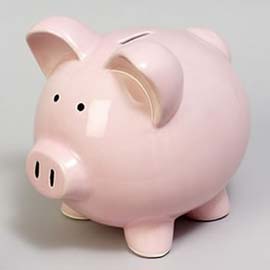
By Gail Johnson | Insight
Allison Bell is on a mission. The 29-year-old Surrey, B.C., resident is looking for a place to call her own. She's
determined topurchase a condo solo, but she has a big hurdle to jump to get there: scraping together enough
cash for a down payment.
"I'm at a place in my life where I'm ready to get into the market," Bell says. "I really want to do this on my own,
without having to go to my parents for help. But it's hard to save up this big lump sum."
Like so many Canadians entering the housing market for the first time, Bell is faced with a tough question: With
interest rates currently so low, do you get into the market at five-per cent down or wait and save for the conservative
20 per cent knowing rates can only go up?
How much do you need for a down payment?
Although you can break into the market with as little as five per cent down, the amount you put down determines
whether you'll have a conventional mortgage or an insured, high-ratio mortgage.
With at least 20 per cent of the home's purchase price as a down payment, you get a conventional mortgage.
A down payment that's less than 20 per cent, meanwhile, requires a high-ratio mortgage and has to be insured by
a third party (such as the Canada Mortgage and Housing Corporation, Genworth Financial Canada, or Canada
Guaranty) and involves you paying an insurance premium, which could run you thousands of dollars.
According to CIBC, the mortgage-default insurance premium you'll have to pay depends on how much you're
borrowing and the percentage of your down payment, but premiums typically range between 0.5 per cent and 2.75
per cent of your total mortgage amount.
This fee can be added to the principal balance and paid off as part of your mortgage or paid in a lump same when
you buy the home.
Do the math
Vancouver independent mortgage broker Karen Gibbard, ofGibbard
Hoffart Financial Group, shares an example of the costs of getting into the market now with a high-ratio mortgage
and waiting to save a 20 per cent down payment to avoid that insurance premium.
She's assumed a 25 year amortization period with a five-year fixed term and a purchase price of $300,000. "I think
that's probably close to what first-time buyers are experiencing as average entry level purchase prices across
Canada," Gibbard says.
Take Scenario A, with a five-percent down payment:
Purchase price: $300,000
Less five percent down payment: - 15,000
= base mortgage: $285,000
+ high-ratio fee: + 7,837.50 (2.75 per cent of the loan amount)
= total mortgage: $292,837.50
"At today's near-historical low interest rate of 3.09 per cent for a five-year fixed term and 25-year amortization, the
monthly payment for this would be approximately $1,399.40 per month," Gibbard says.
And Scenario B, with a 20-per cent down payment:
Purchase price: $300,000
less 20 per cent down payment: - 60,000
= base mortgage: $240,000
"If the interest rates were six per cent by the time they could save up the money, their payments would jump up to
$1,535.54, approximately $136 per month more than in that first scenario with five per cent down.
"Over five years the difference adds up to about $8,168 which is just a little bit more than what the high-ratio fee
was in that first scenario, with five-per cent down [$7,837.50].
"Factoring the rise in potential home values and the possibility of higher rates in the future, there is a case to be
made to look at purchasing now," Gibbard says. "Can first-time buyers really save $60,000 after-tax dollars in a
few years or will it take even longer?"
She points to the projections of Canadian wealth advisor Gordon Pape, who, like most financial experts, says that
with interest rates so low, they can only go up.
"I have always believed that home ownership is one of the four pillars of financial security," Pape writes in his
BuildingWealth.ca newsletter. "So I would never discourage anyone from buying a primary residence as long as
they can afford it.
"When mortgage rates move higher, as they inevitably will, the market price of houses will fall. That is an historic
fact because affordability is a combination of house price and mortgage interest rates. As carrying costs go up,
fewer people can afford the payments.
"So if you are buying a residence now ... be sure you can afford an increase in payments when rates move higher,"
he states.
Potential home owners are always advised to sit down with a financial advisor — whether it's an independent
planner, someone through their bank, or a credit counsellor — to pore over their budget with an eye to the future.
Comments:
Post Your Comment: